With focus and intensity that are already legendary, Bronco Mendenhall is reinventing Cougar football and raising BYU’s colors high in the blue.
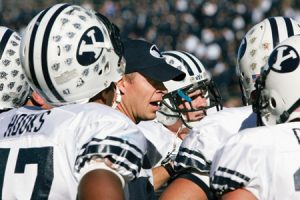
In his second year as BYU’s head football coach, Bronco Mendenhall was named the Mountain West Conference’s coach of the Year and was a finalist for national coach-of-the-year honors.
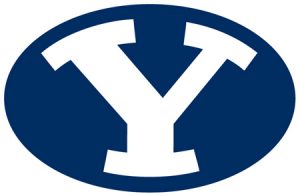
To symbolize his expectations for the team, Mendenhall revived the logo worn during BYU football’s most successful era.
Looking to pass for a TD, [Detmer] bounces out of the pocket. Waiting, waiting . . . here’s the pass—touchdown! . . .
Listen to the crowd! Brigham Young University has upset no. 1 Miami, 28 to 21!
On the eve of Bronco Mendenhall’s first fall camp as head football coach in August 2005, the roar of 65,000 fans echoed across the empty stands of LaVell Edwards Stadium. Scattered across the playing field, 105 street-clothed football players lay on their backs, eyes closed, as voices from the past—projected from the loudspeakers—conjured generations of football heroes who had electrified Cougar Stadium on fall Saturdays.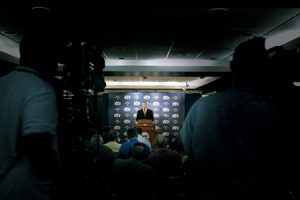 Deep baaall—touchdown! BYU leads. [K.O.] Kealaluhi with the K.O. punch! The sixth touchdown pass of the day for Steve Sarkesian.
Deep baaall—touchdown! BYU leads. [K.O.] Kealaluhi with the K.O. punch! The sixth touchdown pass of the day for Steve Sarkesian.
“You could visualize everything,” remembers running back Curtis Brown (BA ’06). “To listen to it in the stadium was amazing. It sent chills up my spine.” It was the reaction Mendenhall had in mind—to inspire his players through the glory of the past.
Utah 21, BYU 18. 1:33 to go. And from the 30, on the keeper option look, [Doman tosses] to Luke. Luke on the sideline to the 20! To the 15! Gonna go—touchdown, BYU! . . .
Making a break on the ball, Gilford picked it off! Gilford picked it off! . . . He’s dropped at the 30, but the game will be over!
Reliving the Jernaro D. Gilford (BS ’04) interception near the end of BYU’s 12-2 2001 season had to be bittersweet for the players. The thrilling victory over Utah was a high point—but one that wouldn’t last. Within weeks of that game, the football program began a precipitous spiral into mediocrity, and moments of excellence became scarce. The team would suffer three straight losing seasons—the first in three decades. And with 10 home losses during that stretch—three by more than 30 points—the stadium in which Mendenhall’s players lay had become anything but imposing for visiting teams.
But the football team had been losing more than just games. After off-field scandals involving players, the program was losing its positive reputation and gaining national attention for all the wrong reasons, which strained relationships with its fan base and with the university.
So when BYU defensive coordinator Bronco Mendenhall was handed the head-coaching job in December 2004, it came with a mandate that reached far beyond winning games. He took upon himself the task of building up a football program unlike any other in the nation, one aligned with the distinctive mission of BYU and The Church of Jesus Christ of Latter-day Saints.
“I think we’re a flag bearer of the school,” he has said. “I intend to carry that flag up high, not on the ground. If I do my job right, this place will be one of the most dominant programs in the country, as it once was.”
Change
It was 5:30 a.m. when the 38-year-old Bronco Mendenhall, then the second-youngest Division I head football coach in America, stepped into his office on the still-dark second floor of the Student Athlete Building for his first full day on the job. There was nothing on his desk or shelves. “It was a surreal experience. I was wondering, ‘What have I done?’ and, ‘What do I do now?’” he recalls. “I found myself on my knees within minutes.”
Sometime around 8 a.m. a knock interrupted his prayer. At his door stood the patriarch of BYU football, LaVell Edwards (EdD ’78). Edwards set a chair directly in front of Mendenhall’s chair, and the two sat down, knee to knee.
“His first words were ‘You have a tough job.’ Then there was a pause and silence,” says Mendenhall. “It wasn’t very comforting to hear that. But then he just said, ‘But it’s a great job.’ I didn’t know what he meant by either at the time.”
Mendenhall has come to consider Edwards a mentor and an advocate. “It’s nice to have someone who has done the job better than anyone, who clearly understands what it’s like to be a head coach here.” The relationship has helped Mendenhall frame what a BYU football team ought to be.
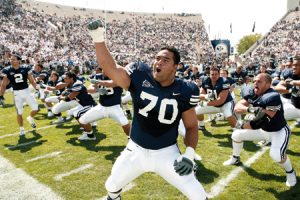
In his coaching career, Bronco Mendenhall has long borrowed symbols and lore from warrior cultures. BYU football players have caught the spirit, performing a Maori warrior dance before each game.
Right away, Mendenhall set on three principles that he felt needed immediate attention—accountability, discipline, and effort. He wanted players who “would do what they said they were going to do at a level that demonstrated precision and discipline.”
But within weeks, it became clear to him that for his team to succeed in every way, he’d need to foster three additional principles—tradition, spirit, and honor. He felt the program ought to reflect the tradition that had been built up by past teams, embrace and exemplify the principles of the Honor Code, and be rooted in the spiritual foundation of the university.
Although Mendenhall had developed a rough sketch of the program in his own mind, he needed to spread that vision throughout the team. So he made a phone call.
Athletics administrators had tipped Mendenhall off to Paul W. Gustavson (BS ’74), who runs a business-consulting firm in San Jose, Calif. A former walk-on to the BYU football team, the business guru had offered his services as a way to pay back the program for its influence in his life.
“I feel that I’ve been a good defensive coordinator,” Gustavson remembers Mendenhall saying over the phone, “but I’ve never been a head football coach. I want to be a great head football coach, and I understand that you can help me.”
The two proved to be a perfect match. Gustavson was a wellspring of ideas, and Mendenhall was a model student. Regularly flying to Utah to meet with the coach, Gustavson would present ideas and leave articles and books on management. By the time Gustavson would return, Mendenhall would not only have underlined and scribbled notes all over the texts but also have taught the principles to his assistant coaches and built team activities around them.
“He’s a master learner,” says Gustavson of Mendenhall, who is now a subscriber to the Harvard Business Review. “He reads, he underlines, he ponders, he prays about it.”
Gustavson typically breezes through lesson one, creating a sustainable competitive advantage, in an afternoon. With Mendenhall, he spent two months. Gustavson emphasized that to compete successfully, an organization cannot be just like its competition. The principle meshed with Mendenhall’s developing vision of BYU football.
“It became clear to me that I was to make the football program as distinct and different as possible,” says Mendenhall, “because this institution and its purpose are distinct and different and unique. BYU isn’t like anywhere else. It wasn’t designed to be.”
Gustavson also stressed that “all organizations are perfectly designed to get the results they get.” BYU’s most recent results were three losing seasons and off-field problems. So if Mendenhall wanted penetrating change, Gustavson insisted, he couldn’t just add a fresh coat of paint to the same structure.
Mendenhall began his remodeling work in earnest one late-winter evening before his first spring camp. Without warning coaches or players, he arranged for buses to show up at a team workout. The buses transported the team to a site up Provo Canyon, where a bonfire was blazing. Mendenhall had team leaders split the players into 10 groups. Handing out pens and large sheets of paper, he told them to write down everything that was wrong with the football program.
“They were writing like crazy,” remembers Mendenhall. “Each group filled four to six sheets.”
Mendenhall then had the players come back together to air their concerns. Each time they finished reading a page, they’d wad it up and throw it on the fire.
“It took an hour and a half to go through that process,” says Mendenhall, who looked on in silence. Finally, when all the pages had been reduced to ashes, he pulled out one of the blue helmets the team had used during its losing seasons and threw it onto the fire. “We’re not going to look like this anymore,” he told them and, for good measure, tossed on the baseball cap he had worn as defensive coordinator as well. “And we’re not going to play like this anymore.”
“There was a symbolic closure,” he says. “Then I asked them what they were willing to do.”
The discussion resulted in a list of season goals that were then appended to a mission statement that the coaching staff had created: “We will be the flag bearers of Brigham Young University through football excellence, embracing truth, tradition, virtue, and honor as a beacon to the world.”
That moment helped rekindle John Beck’s (BS ’06) enthusiasm. As quarterback, he had experienced the brunt of the team’s darkest years. “When we came to BYU, we had dreams of great things. We wanted to accomplish so much—and it wasn’t happening,” he says. “To burn it all up and say, ‘That’s it. It’s done with’—that was a great thing.”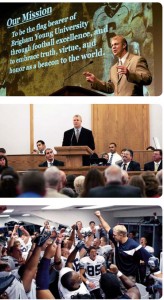
Expecations
Beeeep.
The timer sounded before the player reached the cone. Panting and covered with sweat, he slackened his pace and walked away, head down and hands on his hips.
Mendenhall had implemented the “beep test” at the recommendation of his new assistant coach Brandon G. Doman (BS ’02). Doman had learned the drill as a backup quarterback with the San Francisco 49ers, which had performance goals for each position based on the drill. In the test a player runs back and forth between cones placed 20 yards apart. Before a timer beeps, he must get to the cone and be on his way back. As the drill progresses, the beeps come more quickly until the player misses two consecutive beeps and is out.
Mendenhall watched on in frustration during the spring-camp practice as many players gave up after the first missed beep. Nobody seemed to care whether the team fell short of the standards.
Following practice the coaches gathered in the locker room, on edge after the workout. “What happened?” Mendenhall asked. A lively discussion broke out, with some arguing that it wasn’t fair to hold college athletes to the high standards of a professional team. Mendenhall didn’t buy it. The problem, he insisted, was that expectations for the team’s effort were too low.
In the next morning’s team meeting, Mendenhall told the players that he planned to repeat the drill in two weeks and that this time he expected much better results.
Two weeks later his team outperformed the San Francisco 49ers in every position but one.
“The worst mistake I can make here is to not ask enough of my players,” says Mendenhall. He says this is especially true at BYU “because these young men are of different experience and different upbringing and different maturity than most others I’ve been around.”
High expectations were nothing new to the defensive players, who had endured Mendenhall’s grueling practices for two years. He demanded “fanatical effort,” which meant they run at full speed on and off the field, gang-tackle, and out-hustle opponents.
Mendenhall learned on day one that his brand of intensity wouldn’t be welcomed by everyone. Before even the first team meeting, a player showed up at his office in suit and tie. “This program is not for me,” he told Mendenhall.
When Mendenhall asked why, the player responded, “I know what you’re going to expect, and I’m not willing to do that.” Two more players quit the next day.
“Quite frankly,” says Mendenhall, “they made choices that meet their expectations of where they will be comfortable—which is not here.”
To describe why one player quits and another thrives, Mendenhall refers to a commitment scale he discovered in his management readings. At one end are those who rebel or quit. Next are players who do what is asked, but only out of “malicious obedience.” At the other end of the spectrum are players who act out of “heartfelt commitment” and “creative enthusiasm.” While most players still stand somewhere in the middle, Mendenhall says the commitment level has risen dramatically over two years.
“I have a leadership council and a few captains that I would say are at the top level,” he says.
As his players have risen in their commitment, Mendenhall has entrusted them with more ownership of the program. He instituted a players’ leadership council, made up of elected representatives of each position. Through the council, players can voice ideas and concerns to Mendenhall and the coach can communicate with his team. “For the first month or so they didn’t say much,” says Mendenhall. “Now they speak their minds.”
Mendenhall even allows the leadership council to participate in personnel decisions. Team captains, for example, selected who would play on special teams in 2006. Mendenhall doesn’t know of any other place in the country that gives its players so much sway.
“But I’m not at ‘any other place,’” he says. At BYU, with a team stocked with returned missionaries who have leadership experience, Mendenhall believes his players are up to the task. “I’ve provided an opportunity and a framework for them to actually own the team.”
“Coach Mendenhall doesn’t underestimate us,” says running back Fui Vakapuna (’08). “He wants to bring out the best.”
Honor and Spirit
Eighteen hours before kickoff of the September 2006 BYU-Utah State matchup, Jan Jorgensen (’09) was in uniform for his team’s pregame ritual. But the defensive lineman wasn’t breaking down the Aggie offense, perfecting his technique, or even thinking football.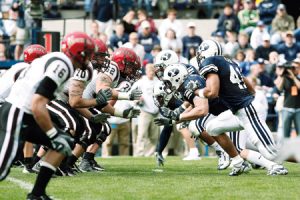
Instead, he was standing at a podium, reading from the Book of Mormon, and asking what it means to be born of God. His uniform? A white shirt and tie. His audience was a mixture of his teammates and members of the Orem Sunset Heights Stake, with a preponderance of boys and young men.
As Jorgensen finished his message, 280-lb. Hala Paongo (BS ’06), another defensive lineman, lumbered up the aisle to the piano. Within a day Paongo would be chasing down Utah State’s quarterback, but this Friday night it was his fingers that were chasing across the piano keyboard as he played a nimble medley of “Come Thou Fount of Every Blessing” and “We’ll Bring the World His Truth.”
When Mendenhall walked to the microphone after the musical number, his cheeks were already wet with tears. “We ask our young men to speak on being disciples of Christ,” he said. “I can’t tell you how edified I am to see different ones each week come up and share their testimonies and say what they believe and then act in accordance with that on a daily basis.”
The fireside tradition was born out of travail during Mendenhall’s first season as head coach. Opening with a 1-3 record, Mendenhall felt uneasy about the team’s direction. The Monday before they were scheduled to play at New Mexico, he told his coaches that he thought they should hold a fireside before the game.
“I was 1-3. I was a new head coach. Things weren’t going well,” Mendenhall says. “I remember the look of ‘How is this going to help?’ on the faces of our coaching staff.”
The response in New Mexico wasn’t exactly resounding—only about 13 people showed. But the team went on to win the game the next day and four of five after that.
Mendenhall won’t say it was the firesides that won those games, but he does believe they helped unite the team and provided a rewarding way to give back to fans. And the response has caught up, with the firesides regularly filling stake centers, particularly for away games. In Boston in 2006, one family drove seven hours to attend the fireside, and the family didn’t even have tickets to the game. “Those events,” says Mendenhall, “more than the game each week, are the highlights of this job to me.” Mendenhall has taken heat for saying such things and even for daring to mix church and sport. His references to Book of Mormon stories—like Helaman’s stripling warriors and Captain Moroni—in an early press conference ignited a debate that raged for weeks in print and on the airwaves.
Mendenhall has taken heat for saying such things and even for daring to mix church and sport. His references to Book of Mormon stories—like Helaman’s stripling warriors and Captain Moroni—in an early press conference ignited a debate that raged for weeks in print and on the airwaves.
But Mendenhall makes no apologies for referencing and nurturing the spiritual. “Spirit is what we represent and is the foundation of this university,” he says. “If our program doesn’t reflect that in a manner that is not subtle but that is solidly aligned, then I think we’ve missed the mark.”
It’s no coincidence that Helaman’s stripling warriors and Captain Moroni came up in the press conference. Mendenhall has long studied the codes and ideals of warrior cultures—from the Samurai to the Maori to the Sioux—and has incorporated their symbols and traditions into his coaching. But Mendenhall has chosen one warrior culture in particular for his team to emulate—Helaman’s stripling warriors. A painting depicting the story of the 2,000 valiant soldiers hangs outside Mendenhall’s office near mural-sized images of Ty Detmer and the 1984 national championship team.
“There is something to be said about young men acting with courage,” he says, “who fight as no one has ever seen young men fight before, who have been taught by their parents and who hold true to that, who perform with exactness.”

Jonny Harline’s time-expired TD grab to beat Utah in the 2006 rivalry game rewarded a season of effort for the football team and years of expectation for BYU fans.
Mendenhall realized right away that building the ranks of his football team depended on finding able and willing troops who not only can play Division I football but also are prepared for the spiritual and academic rigors of BYU’s environment.
“We call the bishop, stake president, minister, pastor, rabbi—whoever is in charge of the young man’s spiritual growth—and ask them, ‘Can this young man thrive in this environment?’” Mendenhall says. “If they don’t answer in the affirmative, we move on.”
The grilling continues when the player visits campus. Before offering a scholarship, Mendenhall sits down with the player and his parents and explains in detail what the recruit would be getting into by signing on—giving special attention to BYU’s Honor Code and spiritual nature, the team’s role as representatives of the Church and BYU, and Mendenhall’s high expectations of his football players.
“He communicates exactly what the expectations are for his team,” says Tom A. Holmoe (BS ’83), athletic director. “It’s very uncommon. A lot of coaches will tell recruits what they want to hear.”
One might think that with so much scrutiny and so many demands on players, BYU’s recruiting pool would be too small to be competitive. While the options are limited, Mendenhall has found the high standards to be more of a help than a hindrance. “They’re coming now because of these things,” he says. “It can be used as a competitive advantage.”
Indeed, BYU’s aggressive strategy to find the best athletes who fit BYU’s culture had yielded 21 verbal commitments for its 2007 recruiting class by July 2006—seven months before the official signing day. This number was second only to the 2005 national champion Texas Longhorns and triple what the rest of all the Mountain West Conference had garnered.
“This is about drawing young men to this program who want to be here,” says Mendenhall, “who want to represent these things with passion and who would play to a different level because they are representing these things.”
But Mendenhall knew that even those willing to commit to BYU’s high standards sometimes struggle in their adjustment to campus life and the Honor Code. To help players live up to their commitments, he came up with a buddy system modeled after missionary companionships. Each player keeps the coach up to date on his brother’s spiritual, academic, and athletic progress in brief weekly letters, which Mendenhall reads on Tuesday evenings. When a player expresses worry about his brother, Mendenhall follows up personally with the player.
Mendenhall says the program has helped head off problems before they erupt. “I feel like we’re giving these young men the best chance to receive the guidance and leadership and counsel they need, with player caring for player.”
It’s all part of Mendenhall’s vision of building leaders through football. “It’s not about football,” he says. “Football is the vehicle.”
Fui Vakapuna, who rejoined the team in early 2006 after serving a mission, says he feels like he is on another mission as a football player. “Coach Mendenhall told me, ‘You’re responsible for the people in your community, for the people outside of the community, and throughout the whole world.’ That hit me,” he says. “You feel the Spirit when you are around him. It’s amazing.”
Tradition
Nineteen years before Mendenhall brought his 2005 squad into LaVell Edwards Stadium to relive past moments of BYU football glory, Mendenhall himself had sprawled out on the same sod to relive highlights of a game—the one he had just played in. It was Nov. 15, 1986, and Mendenhall’s Oregon State Beaver defense had just held the mighty Cougar offense to only one touchdown for a 10-7 OSU victory.
Mendenhall, then the Beavers’ starting safety, had twice been passed over by BYU recruiters—once as a high school senior and again after he had captained the Snow College Badgers to a junior college national championship—so the win had special significance. “I felt like there was justice in the universe,” he says.
But Mendenhall says lying spread eagle on the Cougars’ 50-yard line was far from a gesture of disrespect. It signified how much it meant to him to beat a team of BYU’s stature on its own field. “It was gratifying because of the respect I had for the program, for what it represented to me growing up, which was excellence.”
Mendenhall had that tradition of excellence in mind on the first day of spring camp in April 2005, when buses dropped the team off at the Y Mountain trailhead. Mendenhall didn’t offer any explanation; he just told the team to get to the Y as fast as they could. The herd of players and coaches took off up the pitched switchbacks, arriving at the top in a winded, sweating mass.
As his team caught their breath, Mendenhall had them look out over the expanse of Utah Valley and BYU campus below. With the stunning view before his team and three losing seasons behind it, Mendenhall didn’t need to provide a lengthy motivational speech. He simply noted how much better the view is from the top.
As an exclamation point to the experience, Mendenhall let his players in on a secret: That fall they’d be returning to the traditional white Y helmets, patterned after the helmets the team had worn when it was at the top of its game.
The team was thrilled. “For us players, that really meant a lot,” says John Beck. “That was the symbol we had followed for so long.”
The uniform change was much more than an inspirational device. It was Mendenhall’s way of holding his team accountable to what had come before. To further bolster the connection, he invited Edwards and all football alumni back to campus to attend practices and other events and to address the team. By embracing BYU’s football history, Mendenhall showed he was willing to measure BYU’s future against its legendary past.
It’s one thing for BYU to look like it did during the glory years—it’s quite another to play with the same level of success.
For Mendenhall, the 2005 season was a step in the right direction as the team broke the streak of losing seasons, took second in the conference, and held its own in a bowl game against a PAC 10 opponent. But the coach was hardly satisfied.
It was the 2006 season that gave players and fans alike a feeling of déjà vu. In the regular season, the team averaged nearly 40 points a game on its way to a 10-2 record, an outright conference championship, and a no. 19 national ranking. John Beck was the second-rated passer in the nation, and BYU was fifth in total offense. To top it off, the Cougars beat their rival for the first time since 2001 in a time-expired thriller and won the Pioneer PureVision Las Vegas Bowl, 38-8 over Oregon.
But athletic director Holmoe says Mendenhall’s greatest achievement has been creating a program that the BYU community is once again proud to call its own. “People want to believe in the team because of what it stands for and what it represents.”
On the field as well as off, the Cougars provided plenty of reasons to believe, forging a season’s worth of new classic Cougar memories. They are just the kind of memories that someday might be used to ignite the fire of tradition in another generation of BYU football players lying on their backs in an empty stadium.
Here it is. One play for it all. . . . Snap to John. John backpedals. . . . He’s moving to his left. . . . All kinds of time. Now the heat comes. . . . John Beck is on the run. He throws behind him, and it is—caught for the touchdown! Caught for the touchdown! Caught for the touchdown! . . . Harline by himself in the end zone! The Cougars win it on the final play of the game!
Visit more.byu.edu/2006football to watch highlights from the season.
FEEDBACK: Send comments on this article to magazine@byu.edu.






